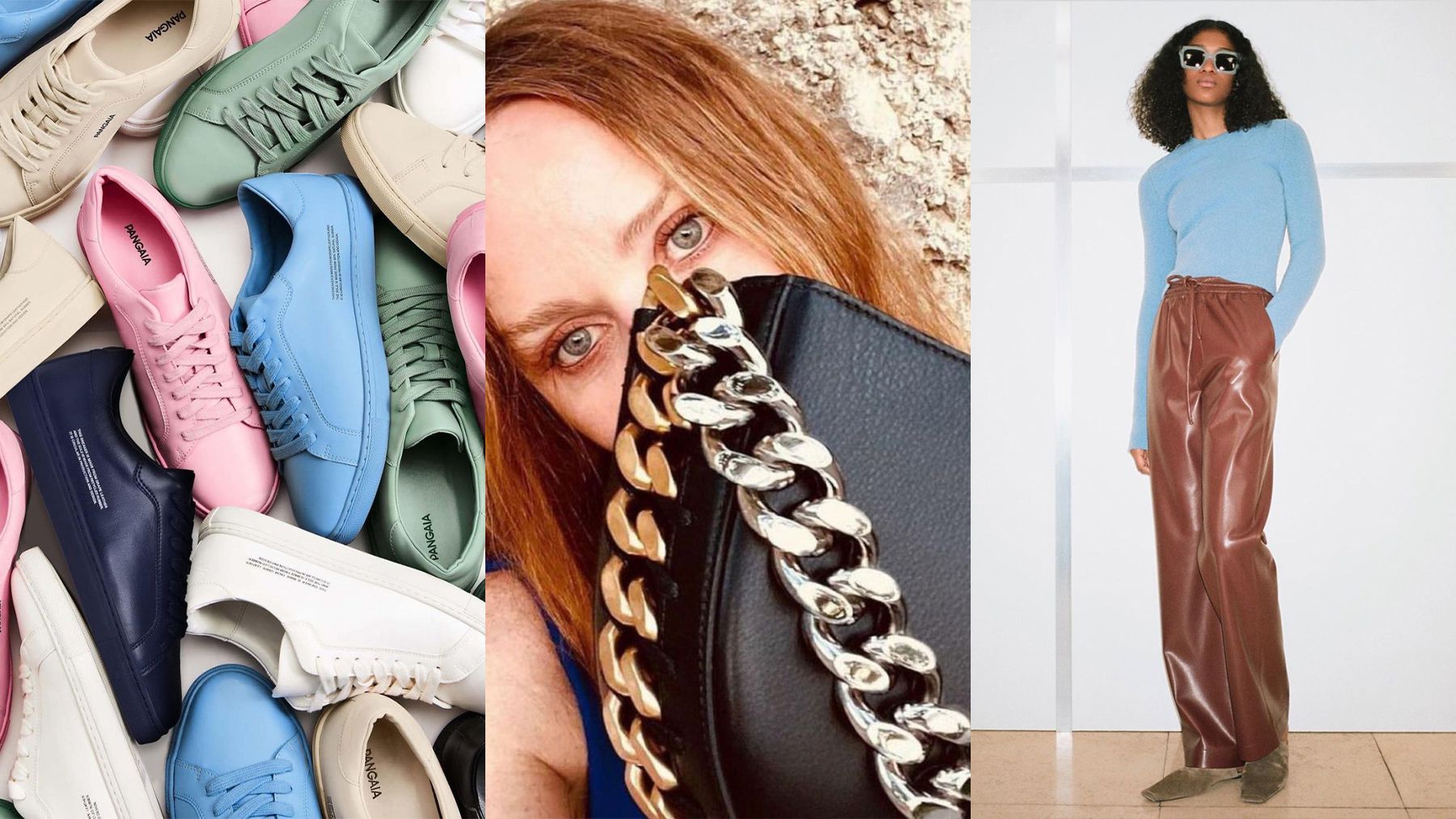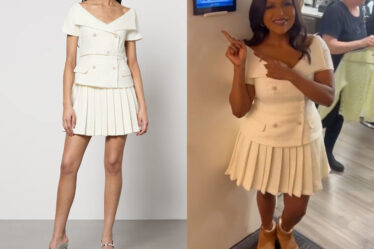
At first glance, there is little to distinguish “materials science” start-up Pangaia’s minimalist white sneakers from the crowd of others on the market.
But in its marketing and in small black print emblazoned across its Grape Leather Sneakers the brand claims key differences: Instead of using leather or fossil fuel-based synthetics, the shoes are made from grape and plant waste, according to a recent Instagram post. Text printed on the shoe bills them as “circular in production and design.”
The sneakers are made from Vegea, an emerging leather alternative that has been used by brands including Ganni and H&M. It’s just under 30 percent plastic, according to the small print on the product’s material composition. It can only be recycled with difficulty, according to information published elsewhere on Pangaia’s website.
The material is one of dozens of fabric innovations beginning to hit the market with flamboyant billing as game-changing eco-conscious alternatives to leather, which has come under fire for its links to animal cruelty and environmentally harmful industrial agriculture.
Exactly how far they deliver on these promises can be difficult to unravel, with brands often employing buzzy but vague marketing terms like “vegan” or “plant-based” to describe materials with vastly different compositions.
At Pangaia, efforts to provide information that’s clear and digestible, but also engaging and fun involve the company’s research and development, impact and communications teams, said chief innovation officer Amanda Parkes. The aim is to strike a balance, with snappy communications layered on top of more detailed information for customers that are interested.
For instance, the brand devotes a page of its website to explaining Vegea’s composition; the fossil content is water-based polyurethane, a less chemically harsh alternative to other options on the market. To account for the recycling challenges, the material was chosen for a “low-wash and long-lasting” product, the page says.
“We know grape leather isn’t perfect and we try to be very clear on the website,” said Parkes. “We are trying to be as correct as possible, but in fashion everyone’s also asking for the one liner.”
Carefully crafting these messages is increasingly important as the materials space becomes more crowded and shoppers look for better information to understand the environmental impact of their purchases. Regulators are also stepping up scrutiny of marketing claims that could mislead consumers and brands need to find ways to more clearly differentiate their products at a time when leather alternatives run the gamut from 100 percent plastic to fully bio-based.
The landscape has become so confusing that nonprofit Textile Exchange has recommended brands stop describing any materials that aren’t derived from animal skins as “leather” to avoid conflating fossil-based synthetics and newer plant-based alternatives.
“It’s a brand new space. It’s very rogue right now, everyones out doing their own thing,” said Sydney Gladman, chief scientific officer at next-generation materials consultancy Material Innovation Initiative (MII). “It’s a huge challenge to figure out how to [communicate] effectively… brands don’t really know how to sell [these new materials] while being transparent and truthful.”
What’s ‘Vegan Leather’ Really Made Of?
The majority of leather alternatives currently on the market are simply variations on conventional plastic. That includes Gen-Z’s first “It” Bag, Telfar’s popular “Bushwick Birkin,” made from a blend of polyester and polyurethane to make it more affordable. It’s also true of many products made by high-end brands like Stella McCartney, who helped rebrand fossil-based synthetics as luxurious vegan materials when she launched her label with a commitment to use no leather in 2001. Plastic still features in McCartney’s faux leather collections, but the brand is seeking out other options.
The most readily available alternatives to fossil-based synthetics are “plant-based” materials that typically blend agricultural waste, food crops or other plants with polyurethane for strength and performance. There’s limited regulation of the space and the term “plant-based” can cover materials like Vegea, which is said to have upwards of 70 percent bio-content, as well as materials with next to none.
A lot of companies “effectively create pleather by another name,” said Allbirds CEO Tim Brown. The San Francisco-based shoe company spent years looking for a plastic-free leather alternative for its sneakers. Last year it invested $2 million in Natural Fiber Welding, an Illinois-based material science company that says its leather alternative Mirum contains only natural ingredients. It’s one of vanishingly few fossil-free options currently available.
Allbirds launched its first shoes using Mirum in September. Ralph Lauren has also invested in the company and other brand partners include Pangaia and Stella McCartney.
Brands don’t really know how to sell [these new materials] while being transparent and truthful.”
Mushroom-based materials, perhaps the most hotly hyped family of leather alternatives, are only just making the leap from research lab to retail. This summer, Stella McCartney launched a capsule of 100 half-moon-shaped mini satchels made of Mylo, one of a number of brands to test drive the material created by California-based material innovation company Bolt Threads. Balenciaga will start selling a dramatic full length coat made of Ephea, an alternative created by Italian biotech company Sqim, at the end of the month.
But while materials made from mycelium, the branching root structure of fungi, have attracted hundreds of millions of dollars in investment and high-profile brand partnerships, the number of products available are still very limited.
Even within the category there are variations between the materials and their properties. For instance, Mylo is a mix of mycelium and plant-based fibre with a water-based polyurethane finish. Ephea is pure mycelium stabilised using green chemistry.
Even more futuristic materials grown or fermented in labs have yet to make it to market in a meaningful way. And adding to the complexity, leather itself is often coated in plastic.
When you “talk to marketing teams they are struggling to grasp how to talk about it to customers,” said Suzanne Lee, CEO and founder of consultancy Biofabricate. “It’s very unsophisticated… there needs to be a little bit more of a nuance.”
Beyond Buzzwords
For brands and innovators, moving beyond a reliance on simplistic buzzwords like “vegan leather” and “plant-based” is becoming increasingly pressing and increasingly fraught.
While the industry is facing a wide-ranging reckoning on greenwashing, there is no standardised way to measure sustainability, or even a clear definition of what the term really means. Leather is a particularly spicy issue: leather goods are a massive financial engine for the industry with a hefty environmental impact, but fossil-based ingredients and chemical processes needed to make most possible replacements competitive on price, performance and durability come with their own environmental footprint. Data to untangle the complex trade offs is sparse and the appropriate metrics hotly debated.
“Just that idea of ‘better,’ it’s woolly,” said Biofabricate’s Lee. “What we don’t need is another generation of materials that in another 10 years we discover are no better… or have unforeseen impacts, either in the way they degrade or in use.”
Plastic is a no go. We can’t market it.’ But innovation will need a little time to catch up.
Biomaterials experts are pushing for more transparency and clearer definitions to address criticisms that risk hobbling and discrediting the emerging sector, including minimum requirements for bio-content and standardised frameworks to measure and report environmental impact.
In the meantime, fuzzy marketing terms have made it easy for critics to dismiss the whole universe of leather alternatives as simply plastic. Some brands will no longer even look at a new innovation unless it can claim it’s fossil free, experts say.
“I’ve never seen an industry so zero to 100,” said MII’s Gladman. “A lot of it comes down to, ‘we have seen this as an emotional hotspot. Plastic is a no go. We can’t market it.’ But innovation will need a little time to catch up.”
A Plastic-Free Future?
When former Jimmy Choo design director Alfredo Piferi launched his luxury footwear label in 2020 with a view to create vegan and climate-friendly party shoes, he quickly discovered he’d set himself a monumental challenge. Simply finding materials that met his quality standards was hard. Supply was limited and expensive.
“I want to do everything in mushroom leather, but then I’d be looking at shoes in black and white,” said Piferi, gesturing to a wall punctuated by pale pink pumps and scarlet boots. “It’s a challenge of working with what exists.”
Faced with a similar challenge, Hungarian brand Nanushka created its own option, Okobor, a roughly 50/50 blend of recycled polyester and polyurethane.
“We have tried and are constantly trying all those materials and monitoring the market for the newest innovations,” said co-founder and CEO Peter Baldaszti, adding that so far, nothing the team has tried could compete with the softness of Okobor. “We are willing to go above and beyond, but sustainability credentials shouldn’t be prioritised above the desirability of the product,” Baldaszti said.
Even as new materials begin to scale, brands and consumers still face complex tradeoffs between performance, price, availability and impact when considering what material to buy – ones brands should make clearer in the way they position and market products.
“It’s important to lean on the facts of what a material is, rather than making big bold claims about the fact it’s here to save the world,” said Lauren Bartley, head of responsibility at Ganni.
The buzzy Danish brand is working to eliminate leather from its collections by 2023, part of a bigger goal to halve its greenhouse gas emissions by 2027 (leather was the single biggest contributor to the brand’s overall carbon footprint in 2021, according to Ganni’s analysis). So far, it’s launched products using Vegea and Mylo and is experimenting with a number of others.
“There’s really no perfect solution for us,” said Bartley.
For more BoF sustainability coverage, sign up now for our Weekly Sustainability Briefing by Sarah Kent.



